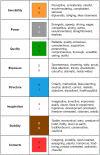Impact of the COVID-19 pandemic on women's perinatal mental health and its association with personality traits: An observational study
- PMID: 36825665
- PMCID: PMC9951299
- DOI: 10.1111/aogs.14525
Impact of the COVID-19 pandemic on women's perinatal mental health and its association with personality traits: An observational study
Abstract
Introduction: The burden of perinatal mental health problems was expected to increase during the COVID-19 pandemic. We prospectively investigated the impact of the COVID-19 pandemic on the mental health of pregnant and postpartum women in Norway and explored associations with their sociodemographic characteristics and personality traits.
Material and methods: Sociodemographic information and the self-reported impact of pandemic on wellbeing of pregnant women was collected using an online survey. To assess women's mental health, two validated questionnaires, the Edinburgh Postpartum Depression Scale (EPDS) and the Generalized Anxiety Disorder-7 item Scale (GAD-7), were used prenatally and postnatally. Personality traits were evaluated using HumanGuide, a web-based ipsative psychological evaluation instrument.
Results: 772 women were included prenatally, of which 526 also responded to the survey 4-6 weeks postnatally. The median age was 29 years, 53.6% of the women were nulliparous when enrolled, and 35.1% worked in the healthcare sector. The median EPDS (6.0; interquartile range [IQR] 3.0-10.0 vs 6.0; IQR: 3.0-10.0) and the median GAD-7 (5.0; IQR 2.0-9.0 vs 5.0; IQR 2.0-9.0) were similar pre-and postnatally. Prenatally, the proportion of women scoring ≥13 on EPDS and ≥10 on GAD-7 was 14.5% (112/772) and 21.5% (166/772), whereas the postnatal figures were 15.6% (82/526) and 21.5% (113/526), respectively. The differences were not significant (P = 0.59 and P = 0.99). Being <25 years of age, being on pre-pregnancy psychotherapy or psychotropic medication, frequent voluntary isolation, perception of maternity care not proceeding normally, avoiding seeking medical assistance due to fear of infection and having negative economic consequences during the COVID19 pandemic significantly increased the risk of both anxiety (GAD-7 ≥10) and depression (EPDS ≥13). Nullipara had a higher risk of anxiety, whereas being a healthcare worker had a lower risk. The personality trait factors Power (P = 0.008), Quality (P = 0.008), Stability (P < 0.001) and Contacts (P < 0.001) were significant predictors of depression among pregnant women, whereas the Quality (P = 0.005) and Contacts (P = 0.003) were significant predictors of anxiety.
Conclusions: During the initial phase of the COVID-19 pandemic, the prevalence of depression (EPDS ≥ 13) and anxiety (GAD-7 ≥ 10) was 14.5% and 21.5%, respectively, among Norwegian pregnant women. Certain sociodemographic characteristics and personality traits were significant predictors of depression and anxiety.
Keywords: COVID-19; anxiety; depression; mental health; perinatal mental health; postnatal depression; pregnancy.
© 2023 The Authors. Acta Obstetricia et Gynecologica Scandinavica published by John Wiley & Sons Ltd on behalf of Nordic Federation of Societies of Obstetrics and Gynecology (NFOG).
Conflict of interest statement
The authors have stated explicitly that there are no conflicts of interest in connection with this article.
Figures



Similar articles
-
Self-reported mental health status of pregnant women in Sweden during the COVID-19 pandemic: a cross-sectional survey.BMC Pregnancy Childbirth. 2022 Mar 28;22(1):260. doi: 10.1186/s12884-022-04553-x. BMC Pregnancy Childbirth. 2022. PMID: 35351030 Free PMC article.
-
Mental health status of pregnant and breastfeeding women during the COVID-19 pandemic-A multinational cross-sectional study.Acta Obstet Gynecol Scand. 2021 Jul;100(7):1219-1229. doi: 10.1111/aogs.14092. Epub 2021 Feb 13. Acta Obstet Gynecol Scand. 2021. PMID: 33475148 Free PMC article.
-
The Impact of the COVID-19 Pandemic on Women's Perinatal Mental Health: Preliminary Data on the Risk of Perinatal Depression/Anxiety from a National Survey in Italy.Int J Environ Res Public Health. 2022 Nov 10;19(22):14822. doi: 10.3390/ijerph192214822. Int J Environ Res Public Health. 2022. PMID: 36429541 Free PMC article.
-
Perinatal mental health and women's lived experience of the COVID-19 pandemic: A scoping review of the qualitative literature 2020-2021.Midwifery. 2023 Aug;123:103706. doi: 10.1016/j.midw.2023.103706. Epub 2023 May 1. Midwifery. 2023. PMID: 37167674 Free PMC article.
-
COVID-19 pandemic and maternal mental health: a systematic review and meta-analysis.J Matern Fetal Neonatal Med. 2022 Oct;35(20):4014-4021. doi: 10.1080/14767058.2020.1843155. Epub 2020 Nov 1. J Matern Fetal Neonatal Med. 2022. PMID: 33135523
Cited by
-
Predictors of Using Pharmacists as a Medication Safety Information Resource Among Women of Reproductive Age.Drug Healthc Patient Saf. 2024 Dec 7;16:125-132. doi: 10.2147/DHPS.S412786. eCollection 2024. Drug Healthc Patient Saf. 2024. PMID: 39664451 Free PMC article.
-
Increased adverse pregnancy outcomes among decreased assisted reproductions during the COVID-19 pandemic: insights from a birth cohort study in Southwest China.BMC Pregnancy Childbirth. 2024 Nov 19;24(1):766. doi: 10.1186/s12884-024-06935-9. BMC Pregnancy Childbirth. 2024. PMID: 39563259 Free PMC article.
-
Social distancing and mental health among pregnant women during the coronavirus pandemic.BMC Womens Health. 2023 Apr 20;23(1):189. doi: 10.1186/s12905-023-02335-x. BMC Womens Health. 2023. PMID: 37081476 Free PMC article.
-
A systematic review and meta-analysis of neuroticism and anxiety during the COVID-19 pandemic.Front Psychiatry. 2024 Jan 5;14:1281268. doi: 10.3389/fpsyt.2023.1281268. eCollection 2023. Front Psychiatry. 2024. PMID: 38250262 Free PMC article.
References
-
- Woody CA, Ferrari AJ, Siskind DJ, Whiteford HA, Harris MG. A systematic review and meta‐regression of the prevalence and incidence of perinatal depression. J Affect Disord. 2017;219:86‐92. - PubMed
-
- Dennis CL, Falah‐Hassani K, Shiri R. Prevalence of antenatal and postnatal anxiety: systematic review and meta‐analysis. Br J Psychiatry. 2017;210:315‐323. - PubMed
-
- Martini J, Petzoldt J, Einsle F, Beesdo‐Baum K, Höfler M, Wittchen H‐U. Risk factors and course patterns of anxiety and depressive disorders during pregnancy and after delivery: a prospective‐longitudinal study. J Affect Disord. 2015;175:385‐395. - PubMed
Publication types
MeSH terms
LinkOut - more resources
Full Text Sources
Medical

